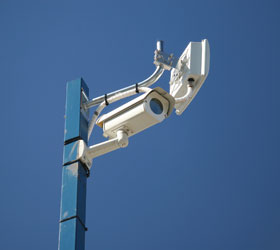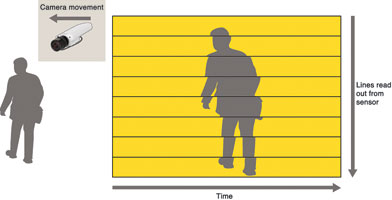

Gusts of wind tearing at a surveillance camera can make it shake or vibrate enough to make images come out as useless blur. A heavy truck, or a train, passing close by can have similar consequences.
A number of different technical solutions have been developed to cope with the problem, with varying degrees of success. However, the introduction of efficient gyroscopes in combination with cutting-edge software programming has accelerated the process towards robust, real-time image stabilisation.
Vibration impact on video output
Improvements in video quality have made the problem with blurry images more apparent. Increasing pixel density, higher resolution and more powerful zooms have not only made cameras more sensitive to vibrations, but have also made viewers more susceptible and prone to noticing them.
Naturally, operators and integrators are aware of these challenges and are trying to address them. For example, vibration can be reduced by choosing sturdier mounts or less exposed locations for the installation.
Image stabilisation makes the entire video surveillance system more versatile and cost efficient by making better use of each camera’s potential, for example by maintaining image quality in zoom shots when vibrations otherwise may have affected the video quality.
Image stabilisation techniques
Image stabilisation techniques are used in consumer products such as digital still cameras and video cameras. Today, there are two methods to tackle the problem – optical image stabilisation and electronic image stabilisation.
Optical image stabilisation
An optical image stabilisation system usually relies on gyroscopes or accelerometers to detect and measure camera vibrations. The readings, typically limited to pan and tilt, are then relayed to actuators that move a lens in the optical chain to compensate for the camera motion. In some designs, the favoured solution is instead to move the image sensor, for example using small linear motors.
Either method is able to compensate the shaking of camera and lens, so that light can strike the image sensor in the same fashion as if the camera was not vibrating. Optical image stabilisation is particularly useful when using long focal lengths and also works well in low light conditions.
The main disadvantage of an optical solution is the price.
Electronic image stabilisation</i>
Electronic image stabilisation, also known as digital image stabilisation, has primarily been developed for video cameras.

Electronic image stabilisation relies on different algorithms for modelling camera motion, which then are used to correct the images. Pixels outside the border of the visible image are used as a buffer for motion and the information on these pixels can then be used to shift the electronic image from frame to frame, enough to counterbalance the motion and create a stream of stable video.
Although the technique is cost efficient, mainly because there is no need for moving parts, it has one shortcoming which is its dependence on the input from the image sensor. For instance, the system can have difficulties in distinguishing perceived motion caused by an object passing quickly in front of the camera from physical motion induced by vibrations.
Rolling shutter distortion
Many video cameras, especially cameras with CMOS sensors, come with a rolling shutter. Unlike a global shutter, which exposes all pixels at the same time in a single snapshot, the rolling shutter catches the image by scanning across the frame, line by line. In other words, all parts of the image are not captured at the same time, but each line is exposed during a slightly different time window. Shakes or vibrations of the camera will therefore result in each exposed line being slightly moved in relation to the other lines, causing a warped or wobbled image. Fast moving objects may also appear distorted in a similar way.

Rolling shutter distortion induced by vibrations can be avoided with optic stabilisation, which instantaneously compensates for the motion. Electronic stabilisation methods have a slight disadvantage in this case. The rolling shutter must first scan at least one line before the digital processing to stabilise the image can begin. Nevertheless, this method works very well and the technology is improving rapidly.
An outstanding combination
The development of affordable gyroscopes together with more efficient algorithms for modelling camera motion has made stabilisation techniques more available.
It has also enabled the creation of hybrid systems that use gyroscope measurements, not to move the lens, but to process the images digitally according to those gyroscopic signals. Axis has chosen this combined method because of its versatility. The solution is designed to cover a wide band of frequencies as well as coping with high and low amplitudes. Advanced gyroscopes together with optimised algorithms make a robust and reliable system. Even in poor lighting environments the system performs very well since it is relying on gyroscopic information, rather than video content, for motion calculations. For the same reason, the system can always distinguish between perceived motion caused by passing objects and physically induced vibrations.
Benefits and applications in video surveillance
A surveillance camera mounted in an exposed location such as on a high pole or a street sign near a busy road, can be shaken by winds or passing traffic, which will blur the video. This is especially true when a powerful telescopic zoom is used. When zooming in on a distant object, the field of view becomes narrower and any shake or tremble will be amplified in the camera – and the amplitude of the shake will increase proportionally to the amount of zoom used.
Therefore, image stabilisation should be regarded as a prerequisite for cameras with zoom lenses, so they can be used optimally also in windy weather or other unfavourable circumstances. Having cameras that are less sensitive to vibrations also makes installation more flexible and allows for multiple mounting options. In the end, fewer cameras may be needed to satisfy surveillance requirements.
A perhaps less obvious advantage of image stabilisation is that privacy masking can be made more precise. On a camera without any stabilisation system, the effects of possible shakes and vibrations would have to be compensated by increasing the masked off area in the image.
Finally, stabilised images will save bandwidth use and storage space. Advanced video compression formats, such as H.264, are based on motion compensation. In short, this method uses the image of a single frame as a baseline and then only saves information about changes in the picture. A well stabilised image will contain comparatively less movement and thus require less bandwidth and storage.
Conclusion
Hardware and software development are making efficient video stabilisation techniques affordable for an ever-increasing range of network cameras. This progress not only secures smooth, comfortable video monitoring in real time. It also enhances image usability, improves camera operability, makes installation more flexible and, finally, improves the overall cost efficiency of a network camera surveillance system.
For more information contact Axis Communications, +27 (0)11 548 6780, sasha.bonheim@axis.com, www.axis.com
| Tel: | +27 11 548 6780 |
| Email: | marcel.bruyns@axis.com |
| www: | www.axis.com |
| Articles: | More information and articles about Axis Communications SA |

© Technews Publishing (Pty) Ltd. | All Rights Reserved.